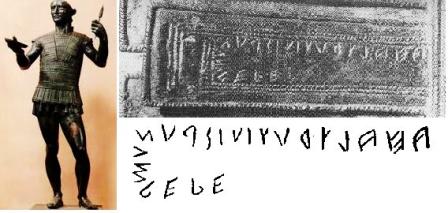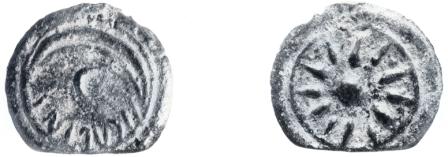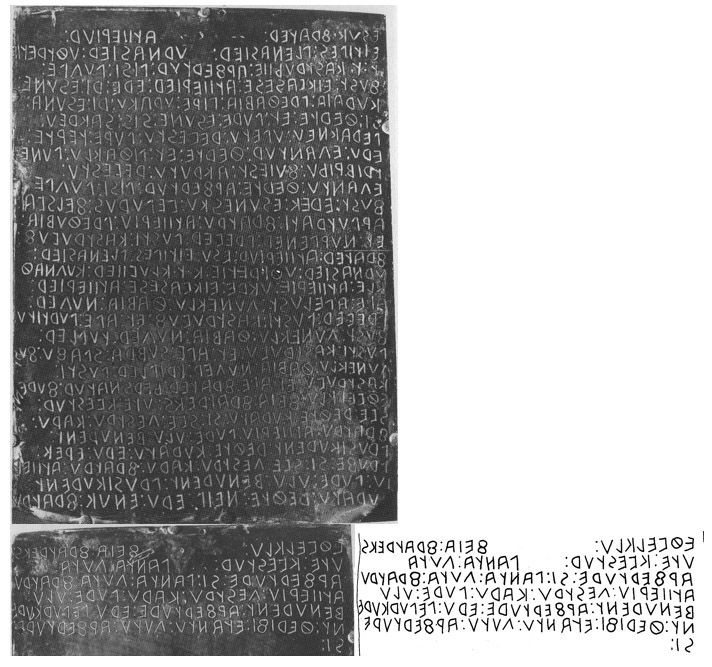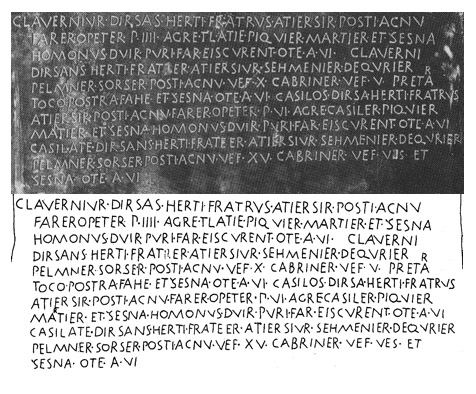Examples of writing
‘Mars of Todi’ (beginning 5th - end 4th centuries B.C.) -Alphabet of Etruscan origin

Source:
http://www.centroarte.com/etruschi.htm
Transcription:
AHALTRUTITISŘUNUMŘEŘE
Interpretation:
AHAL TRUTITIS ŘUNUM ŘEŘE
EXAMPLE OF WRITING ON BRONZE. Bronze statue of a standing warrior, commonly called “Mars”, cm. 141 high. The statue was found in 1835 at the foot of the Monte Santo near the site of Tuder (more or less corresponding to present-day Todi) and is currently held in the Vatican Museums. With regard to dating, most experts towards the beginning of the 4th century B.C., while others would increase the date slightly to the end of the 5th century B.C.. The inscription, located on one of the front fimbriae of the armor, is in scriptio continua (i.e. without any sign of separation between the words) along the marginal line of the fimbria so as to bend at the words řunum and řeře. The writing is right to left and the characters, for the inclined shape and some irregularities, can be attributed not only to an archaic phase of writing, but, according to Roncalli, also to an Etruscan hand. Thus, the inscription of ‘Mars of Todi’ is, to date, not only the oldest example of Etruscan-based writing, but also of the entire corpus. As for the interpretation of the text, it seems to be an inscription of dedication in which two nominal forms can be recognized Ahal and Trutitis, identified by name and the gens/family dedication and a formula expressed by the words řunum and řeře corresponding to the Latin donum dedit. Finally, it is noteworthy that the sign of h is made with a sign normally used in Etruscan ( ) and not with what later becomes the typical Etruscan-based Umbrian sign (
) and not with what later becomes the typical Etruscan-based Umbrian sign ( ).
).
BRONZE FOIL FROM AMELIA (date uncertain - perhaps 4th - 3rd centuries B.C.) - Alphabet of Etruscan origin

Source: Museo Archeologico di Napoli
Side A
Transcription
[…]ŘUVI ŘUN ŘR[…]
[…]HERINTIES IST[…]
[…]TUŘIS A S HU[…]
[…]ΘUΘIU T I VEN[…]
[…]AHATRUNIE[…]
Faccia B
Transcription
[…]E ŘUVIE ŘUNU Ř[…]
[…]HERINTIE ISTUR[…]
[…]ḤURTENTIUS x[…]
[…]ETVEŘIS T I Vx[…]
EXAMPLE OF WRITING ON BRONZE. Opistograph bronze foil, 4.8 cm high and 5.7 cm. long. The document, currently kept at the Archaeological Museum of Naples, was found during the eighteenth century in the town of Lagoscello in ancient Ameria, probably within a tomb. The date is uncertain, but given the greater regularity of the letters, for signs of separation between words and the linearity of the lines that make up the text, the inscription is certainly later than that of the Mars of Todi. Epigraphically, the presence of two signs regularly used in Etruscan is singular and atypical compared to later Etruscan-based Umbrian writing, e.g. in the Tablets from Gubbio; these signs are:
- the sign of F (
 ), transcribed with v (see, for example, the word řuvi / řuvie) that is used to indicate the sound [w], similar to the Etruscan, where the Umbrian generally uses the sign
), transcribed with v (see, for example, the word řuvi / řuvie) that is used to indicate the sound [w], similar to the Etruscan, where the Umbrian generally uses the sign  ;
;
- the sign of h expressed with the sign
 , identical to the Mars of Todi, and not with the more common and later
, identical to the Mars of Todi, and not with the more common and later 
Also, the presence of the sign for theta expressed in a simple circle (O) without any internal point is unique. The writing reads from right to left. The regularity of the letters indicates a later date, but the presence of the writing anomalies indicating a particular influence of Etruscan and its alphabet would lead to a dating of the document (or at least of the inscription) to a period prior to the Iguvine Tablets and therefore probably to the late 4th - early 3rd centuries B.C. It is however not inconceivable that these variations result from a local writing tradition different from that of Gubbio, rather than from the greater antiquity of the text.
The content is not entirely clear, but judging from the presence of the word řuvi / řuvie řuvie (commonly interpreted as a citation of Jupiter in the oblique case) on both sides followed by the words řun / řunu (commonly interpreted as the Latin donum) and řr / ř (usually interpreted as equivalent to the Latin abbreviation dederunt), one could hypothesize that this document represents a dedication. This interpretation would not only be confirmed by the presence of the word herinties from the root *her-, connected with the semantic sphere of ‘will’, ‘want’, which could be understood as a form similar to the formulas libentes, volentes of dedications in Latin language, but it could also lead to seeing the word ahatrunie as a term referring to the deity, surely giovia, , recipient of the dedication.
Finally, there is what is likely a gens/family name and it is certain that the two texts written on the two sides are connected to each other and, therefore, attributable to a single dedication.

Source: Palazzo dei Consoli di Gubbio
Transcription:
PE PE UFEŘIER UHTUR
EXAMPLE OF WRITING ON STONE. Stone sarcophagus lid, decorated with a rosette at the center towards which two horses are directed and writing on one long side. Currently, the cover is in the Palazzo dei Consoli in Gubbio where the more famous Iguvine Tablets are kept as well. The inscription, which reads from right to left, has very smooth and linear characters, with separation between words. These features, combined with the style of the cover, place the document in the 2nd century B.C. The content of this inscription is of great importance because in addition to the usual onomastic indication of the deceased (whose name is Ufeřier), it contains the word uhtur that, on the basis of comparison with other texts (in particular the Iguvine Tablet 5), seems to express not only the position of judge which the deceased held, but also one of the supreme magistracies of the Umbrians referred to using the same word.
COIN CAPTION (3rd B.C.) - Alphabet of Etruscan origin

Source: Museo Nazionale Romano - Medagliere
Transcription
IKUVINI
EXAMPLE OF APPLICATION OF BRONZE. Bronze coin (aes grave) bearing the ikuvini legend which corresponds to the gens/family iguvini (from the early name of the city of Gubbio – Iguvium – and written with the sign k that in Umbrian expressed both the sound [k] and [g]). The coin, weighing 88.22 gr. (found in some Etruscan “wheel” coin series ), is slightly damaged and features a star-like image with twelve rays on the front, and on the reverse a sort of crescent moon, four stars and the legend of the ikuvini coins. Currently, it is held in the Medals Section at the National Roman Museum. The handwriting, quite regular and similar to that of Iguvine Tablets 3 and 4, points toward a dating from the 3rd century or even the end of the 4th century B.C.
TABLETS FROM GUBBIO (probably end of the 2nd century B.C.) - Alphabet of Etruscan origin

Source: Palazzo dei Consoli di Gubbio
Tablet no. 5
Side A
Transcription:
ESUK FRATER ATIIEŘIUR
EITIPES PLENASIER URNASIER UHTRETIE
T. T. KASTRUÇIIE AŘFERTUR PISI PUMPE
FUST EIKVASESE ATIIEŘIER ERE RI ESUNE
KURAIA PREHABIA PIŘE URAKU RI ESUNA
SI HERTE ET PURE ESUNE SIS SAKREU
PERAKNEU UPETU REVESTU PUŘE TEŘTE
ERU EMANTUR HERTE ET PIHAKLU PUNE
TRIBŘIÇU FUIEST AKRUTU REVESTU
EMANTU HERTE AŘFERTUR PISI PUMPE
FUST EREK ESUNESKU VEPURUS FELSVA
AŘPUTRATI FRATRU ATIIEŘIU PREHUBIA
ET NUŘPENER PREVER PUSTI KASTRUVUF
FRATER ATIIEŘIUR ESU EITIPES PLENASIER
URNASIER UHTRETIE K. T. KLUVIIER KUMNAH
KLE ATIIEŘIE UKRE EIKVASESE ATIIEŘIER
APE APELUST MUNEKLU HABIA NUMER
PREVER PUSTI KASTRUVUF ET APE PURTITU
FUST MUNEKLU HABIA NUMER TUPLER
PUSTI KASTRUVU ET APE SUBRA SPAFU FUST
MUNEKLU HABIA NUMER TRIPLER PUSTI
KASTRUVU ET APE FRATER ÇERSNATUR FURENT
EHVELKLU FEIA FRATREKS UTE KVESTUR
SVE REHTE KURATU SI SVE MESTRU KARU
FRATRU ATIIEŘIU PURE ULU BENURENT
PRUSIKURENT REHTE KURATU ERU EŘEK
PRUFE SI SVE MESTRU KARU FRATRU ATIIEŘ
IU PURE ULU BENURENT PRUSIKURENT
KURATU REHTE NEIP ERU ENUK FRATRU
Side B, 1-7
Transcription:
EHVELKLU : FEIA : FRATREKS
UTE : KVESTUR : PANTA : MUTA
AŘFERTURE : SI : PANTA : MUTA : FRATRU
ATIIEŘIU : MESTRU : KARU : PURE : ULU
BENURENT : AŘFERTURE : ERU : PEPURKURE
NT : HERIFI : ETANTU : MUTU : AŘFERTURE
SI :
EXAMPLE OF WRITING ON BRONZE. The tablets are all in bronze and with the exception of nos. 3 and 4 are all opistograph. All seven tablets were written in the Umbrian language, using either the Etruscan- or the Latin-based alphabets. They are organized in a conventional but non-chronological way with the turning point in tablet 5, side B, which features writing using alphabets of both Etruscan and of Latin origin. Based on this conventional division, it is usual to indicate the tablets written with the Etruscan-based alphabet as nos. 1, 2, 3, 4 and 5 (side A and part of the side B), and those using a Latin alphabet with nos. 5 (the final part of side B), 6 and 7. In general the contents of the seven tablets involve a complex ritual that includes ceremonies with sacrifices and offerings to various deities, and rules governing the operation of the Atiedii Brotherhood, charged with these ceremonies.
The tablet shown here is no. 5 which, like the tablets nos. 1, 2, 6 and 7, is opistograph. Side A and the beginning of side B (lines 1-7) were written in Umbrian using an Etruscan alphabet that according to J. Heurgon shows innovations possibly indicating it is an Etruscan alphabet of Cortona origin.
A livello epigrafico, oltre al comune andamento sinistrorso, si notano la divisione delle parole effettuata tramite l’impiego dei due punti e la presenza di un ductus che sembra più recente delle tavole 1-4 dato che il segno per m viene rappresentato graficamente con il simbolo  ; che, secondo J. Heurgon, si connoterebbe per essere un’innovazione rispetto al più comune
; che, secondo J. Heurgon, si connoterebbe per essere un’innovazione rispetto al più comune  . Lexically, note the presence of uhtretie (line 2) which represents the name of an Umbrian judiciary derived either from the term uhtur (which appears three times in the Iguvine Tablets), or from oht. (in abbreviated form in an inscription from Assisi) According to Devoto, this term could be connected to the Latin auctor and, therefore, the term uhtretie could be translated with the expression “under the guidance of ...”. Finally, considering the content, tablet 5 contains the rules for the operation of the Atiedii Brotherhood entrusted with the execution of the religious practices outlined on the tablet. Tablet 5 is thus a decree that regulates the ceremonies under the supervision of the Atiedii Brotherhood, mentioned here for the first time. These ceremonies were composed of three key moments: the slaughter of the animals, the sacrifice itself and the destruction of the victim with its distribution.
. Lexically, note the presence of uhtretie (line 2) which represents the name of an Umbrian judiciary derived either from the term uhtur (which appears three times in the Iguvine Tablets), or from oht. (in abbreviated form in an inscription from Assisi) According to Devoto, this term could be connected to the Latin auctor and, therefore, the term uhtretie could be translated with the expression “under the guidance of ...”. Finally, considering the content, tablet 5 contains the rules for the operation of the Atiedii Brotherhood entrusted with the execution of the religious practices outlined on the tablet. Tablet 5 is thus a decree that regulates the ceremonies under the supervision of the Atiedii Brotherhood, mentioned here for the first time. These ceremonies were composed of three key moments: the slaughter of the animals, the sacrifice itself and the destruction of the victim with its distribution.
TABLETS FROM GUBBIO (probably end of the 2nd - beginning of the 1st centuries B.C.) - Alphabet of Latin origin

Source: Palazzo dei Consoli di Gubbio
Tablet 5, Side B, lines 8-18
Transcription:
CLAVERNIUR DIRSAS HERTI FRATRUS ATIERSIR POSTI ACNU
FARER OPETER P. III AGRE TLATIE PIQUIER MARTIER ET S̀ESNA
HOMONUS DUIR PURI FAR EISCURENT OTE A VI CLAVERNI
DIRSANS HERTI FRATER ATIERSIUR SEHMENIER DEQURIER
PELMNER SORSER POSTI ACNU UEF X CABRINER UEF V PRETRA
TOCO POSTRA FAHE ET S̀ESNS OTE A VI CASILOS DIRSA HERTI FRATRUS
ATIERSIR POSTI ACNU FARER OPETER P VI AGRE CASILER PIQUIER
MARTIER ET S̀ESNA HOMONUS DUIR PURI FAR EISCURENT OTE A VI
CASILATE DIRSANS HERTI FRATEER ATIERSIUR SEHMENIER DEQURIER
PELMNER SORSER POSTI ACNU UEF XV CABRINER UEF VIIS ET
S̀ESNA OTE A VI
EXAMPLE OF WRITING ON BRONZE. Opistograph bronze tablet that is part of a group of 7 slender tablets of various measures ranging from a minimum of cm. 28 x 56 (tablet no. 3) to a maximum of cm. 39 x 83 (tablet no. 7). Found by chance in 1444 at the Roman Theatre of Gubbio and purchased by the town of Gubbio in 1456, these tablets are currently exhibited in the Palazzo dei Consoli in Gubbio. The tablets are all in bronze and with the exception of nos. 3 and 4 are all opistograph. All seven tablets were written in the Umbrian language, using either the Etruscan- or the Latin-based alphabets. They are organized in a conventional but non-chronological way with the turning point in tablet 5, side B, which features writing using alphabets of both Etruscan and of Latin origin. Based on this conventional division, it is usual to indicate the tablets written with the Etruscan-based alphabet as nos. 1, 2, 3, 4 and 5 (side A and part of the side B), and those using a Latin alphabet with nos. 5 (the final part of side B), 6 and 7. In general the contents of the seven tablets involve a complex ritual that includes ceremonies with sacrifices and offerings to various deities, and rules governing the operation of the Atiedii Brotherhood, charged with these ceremonies.
The tablet shown here is part of side B of tablet 5 (lines 8-18) written in Umbrian with a Latin alphabet. Epigraphically, besides being written left-to right, as is typical of the Umbrian language written using the Latin alphabet, words were separated with a single point, as opposed to the two points used to separate words in Umbrian written using an Etruscan alphabet. There is then the use of the digraph RS (l. 8 dirsas; l. 11 dirsans) to express the value of ř (with the Latin alphabet sometimes also written simply as S, but more rarely, only as R) and the use of ̀S with a diacritical mark to express the value of ç (lines 13 and 18: ˋsesna) occasionally also represented with a simple S. Lexically, the abbreviated word uef(ras) corresponding to the Latin lib(ras) demonstrates the phonetic differences between Latin and Umbrian and the phonetic peculiarities in which the l > v/u and the original mid-word aspirate *-bh- of Indo-European in an internal position becomes b in Latin and f in the Italic languages, including Umbrian. Finally, in terms of content, this tablet is very close to tablet 7, side B in which there are the requirements for a ritual ceremony. From this similarity of contents it may be concluded that the two texts are not chronologically distant and that therefore the part of side B written using a Latin alphabet was written around the beginning of the 1st century BC.